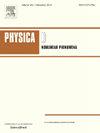Gradient-enhanced PINN with residual unit for studying forward-inverse problems of variable coefficient equations
IF 2.7
3区 数学
Q1 MATHEMATICS, APPLIED
引用次数: 0
Abstract
Physics-informed neural network (PINN) is a powerful emerging method for studying forward-inverse problems of partial differential equations (PDEs), even from limited sample data. Variable coefficient PDEs, which model real-world phenomena, are of considerable physical significance and research value. This study proposes a gradient-enhanced PINN with residual unit (R-gPINN) method to solve the data-driven solution and function discovery for variable coefficient PDEs. On the one hand, the proposed method incorporates residual units into the neural networks to mitigate gradient vanishing and network degradation, unify linear and nonlinear coefficient problem. We present two types of residual unit structures in this work to offer more flexible solutions in problem-solving. On the other hand, by including gradient terms of variable coefficients, the method penalizes collocation points that fail to satisfy physical properties. This enhancement improves the network’s adherence to physical constraints and aligns the prediction function more closely with the objective function. Numerical experiments including solve the forward-inverse problems of variable coefficient Burgers equation, variable coefficient KdV equation, variable coefficient Sine–Gordon equation, and high-dimensional variable coefficient Kadomtsev–Petviashvili equation. The results show that using R-gPINN method can greatly improve the accuracy of predict solution and predict variable coefficient in solving variable coefficient equations.
带残差单元的梯度增强PINN研究变系数方程正逆问题
物理信息神经网络(PINN)是研究偏微分方程(PDEs)正逆问题的一种强大的新兴方法,即使在有限的样本数据中也是如此。变系数偏微分方程模拟了现实世界的现象,具有重要的物理意义和研究价值。针对变系数偏微分方程的数据驱动求解和函数发现问题,提出了一种梯度增强带残差单元的偏微分方程(R-gPINN)方法。该方法一方面在神经网络中引入残差单元,减轻了梯度消失和网络退化,统一了线性和非线性系数问题;在这项工作中,我们提出了两种类型的剩余单元结构,以提供更灵活的解决方案。另一方面,通过包含可变系数的梯度项,该方法惩罚了不满足物理性质的并置点。这种增强提高了网络对物理约束的依从性,并使预测函数与目标函数更紧密地保持一致。数值实验包括求解变系数Burgers方程、变系数KdV方程、变系数sin - gordon方程、高维变系数Kadomtsev-Petviashvili方程的正逆问题。结果表明,在求解变系数方程时,采用R-gPINN方法可以大大提高预测解和预测变系数的精度。
本文章由计算机程序翻译,如有差异,请以英文原文为准。
求助全文
约1分钟内获得全文
求助全文
来源期刊

Physica D: Nonlinear Phenomena
物理-物理:数学物理
CiteScore
7.30
自引率
7.50%
发文量
213
审稿时长
65 days
期刊介绍:
Physica D (Nonlinear Phenomena) publishes research and review articles reporting on experimental and theoretical works, techniques and ideas that advance the understanding of nonlinear phenomena. Topics encompass wave motion in physical, chemical and biological systems; physical or biological phenomena governed by nonlinear field equations, including hydrodynamics and turbulence; pattern formation and cooperative phenomena; instability, bifurcations, chaos, and space-time disorder; integrable/Hamiltonian systems; asymptotic analysis and, more generally, mathematical methods for nonlinear systems.
 求助内容:
求助内容: 应助结果提醒方式:
应助结果提醒方式:


